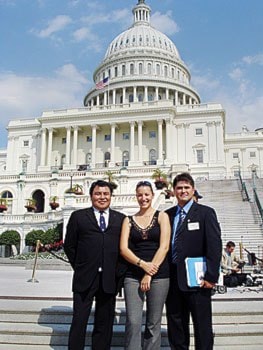Darius Elias, MLA for Vuntut Gwitchin, says reports of a high-tech slaughter of Porcupine caribou near the Dempster Highway come to him as no surprise.
“Make no mistake, this is not an isolated incident,” he said. “It’s happened before. I’ve seen it with my own eyes, and so have many other Yukoners.”
Last week two Yukon men reported that, while driving the highway near the Northwest Territories border, they came across a string of six to eight pickups, driven by hunters who used high-frequency radios, all-terrain vehicles and high-powered rifles to shoot the few caribou in sight.
The firestorm that followed has revealed rifts among aboriginal leaders, pitting those in the Yukon against those in the Northwest Territories.
And it has led to an unlikely scenario, in which Gwitch’in leaders are blaming the Yukon government for not imposing restrictions upon their cherished right to hunt.
Elias, a Liberal, wasted no time in blaming the caribou slaughter on the Yukon Party government.
Elaine Taylor, the Environment minister, “must do something before it’s too late,” said Elias.
The Yukon government erred when it decided to drop a 500-metre no-hunting corridor surrounding the Dempster, he said.
That regulation was dropped last autumn after the Supreme Court of Canada ruled, in another case, that the aboriginal right to hunt trumps provincial and territorial hunting rules.
The no-hunting corridor is still on the books, but it is no longer enforced.
Also no longer enforced is a regulation that allowed the leaders of the migrating Porcupine herd to pass the highway without being shot.
“They’ve caved into some pressures,” Elias said of the Yukon government, “and that’s wrong.”
Taylor said the Yukon government will not create new hunting rules without first consulting other levels of government and aboriginal groups that form the Porcupine Caribou Management Board.
Any new hunting rules would come from a management plan being worked on by the board, she said. A draft plan is to be completed later this autumn.
In the meantime, more conservation officers have been sent to monitor hunting on the Dempster, she added.
Even if the corridor were still being enforced, conservation officers say that caribou shot last week near the highway were beyond the corridor limits.
That doesn’t matter, Elias said.
He’s heard of other instances, he said, where caribou had been shot in a reckless fashion within the corridor boundaries.
He has also heard of hunters driving pickups off the highway in pursuit of caribou, he said.
“People phone me and say, Darius, I was walking, packing a caribou back, and a pick-up truck drove right out beside me.”
Conservation officers, who observed last week’s highway hunt, said they saw no rules being broken.
But there are currently few rules for them to enforce, other than ensuring that no meat is wasted.
Meanwhile, the two men who witnessed last week’s hunt fear what they saw is only the beginning of a bigger slaughter to come.
They say the trucks involved bore Northwest Territories licence plates.
Similarly, Elias said other reports he has heard typically involve “people with polar bear plates on the back of their truck.”
This, understandably, has not sat well with Gwitch’in leaders in the NWT, who insist their hunters would not condone such practices as chasing caribou by ATV.
Others in the NWT have responded by asking how highway hunting differs from the practice of Old Crow residents shooting caribou by boat as the herd crosses the Porcupine River.
To this, Elias replied that the hunting practices of Old Crow residents are “ancient.”
“It’s not an ancient cultural practice, driving out there on the tundra, and filling up your truck with gutted, cut-in-half caribou.”
Reckless hunters are a minority, Elias said, but it may not take many to put the herd in peril.
The current health of the Porcupine herd is uncertain.
Aerial counts of the herd have been thwarted by bad weather since 2001, when the population was estimated to be 123,000.
Researchers say the actual number now sits at around 115,000. That’s a significant decline from in 1989, when 178,000 caribou were seen.
If hunting continues as usual, with about 4,000 caribou shot annually, the herd will continue to dwindle to only 20,000 animals in 15 years, according to the Porcupine Caribou Management Board.
This steep decline could be lessened if hunting was halved, to only 2,000 caribou taken annually, although the herd would still shrink.
To stabilize the herd, not only do hunters need to take less caribou, they need to avoid shooting cows.
Each young cow that is killed is equal to 23 fewer caribou being available in the next 10 years, due to the number of offspring, and offspring of offspring, the cow would have produced.
The two Yukon men who saw the highway hunt said they believed they saw cows being shot.
Other than indiscriminate hunting, there are two other wildcards that may affect the survival of the Porcupine herd, Elias said.
The first is climate change. The second is proposed oil drilling in the Porcupine herd’s calving grounds in Alaska’s Arctic National Wildlife Reserve.
This week Elias visited Washington, DC, to lobby against drilling in ANWR. He received a warm reception, he said.
The fact that both Democratic and Republican presidential candidates alike have positions against drilling in the ANWR is, Elias said, “testament to 20 years of sacrifice and hard work of Gwitch’in and Yukoners” who have campaigned to protect the Porcupine herd.
